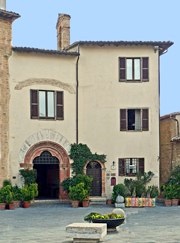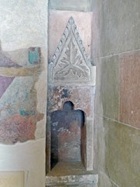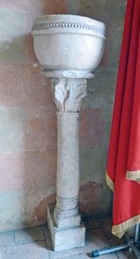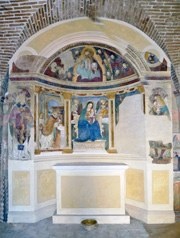


The first church, which is also known as Santa Maria de Platea, is documented from the early 13th century, and was used for the meetings of the Commune in its early years. The Commune ceded it to the Confraternita del Sacramento in ca. 1500, and they rebuilt it following the Apostolic Visit of 1571
The original portal survives, but its terracotta surround was added in the 20th century.
Interior


Frescoes (1517)

The confraternity commissioned these frescoes from Francesco Melanzio in 1517 for the niche in the altar wall. They depict:
-
✴the Madonna and Child enthroned, with two angels;
-
✴St Gregory celebrating Mass, to the left, which is signed by Francesco Melanzio;
-
✴a lost figure of the penitent St Jerome, to the right;
-
✴SS Fortunatus and Severus (probably a self-portrait), to the sides;
-
✴God the Father, in the lunette above; and
-
✴traces of figures of the Annunciation in tondi, above and to the sides.
A panel (1497) in the deposit of the Pinacoteca Vaticana, Rome, which is dated by inscription but of otherwise unknown provenance, depicts:
-
✴the Assumption of the Virgin;
-
✴St Gregory celebrating Mass, to the left;
-
✴the penitent St Jerome, to the right.
The image of St Gregory is extremely close to that in Santa Maria di Piazza, which suggests that the panel in Rome is also by Francesco Melanzio.





